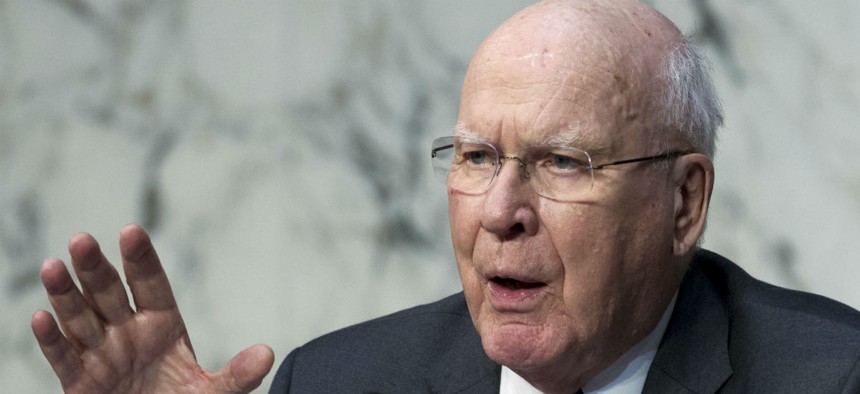
Sen. Patrick Leahy, D-Vt., questioned the director of USPTO about any potential reorganization. Jose Luis Magana/AP
Patent Office Director: No 'Significant' Reorganization Planned
The agency tasked with adjudicating intellectual property claims will continue to staff up in the coming years to tackle the patent application backlog.
In testimony on Capitol Hill last week, U.S. Patent and Trademark Office Director Andrei Iancu told lawmakers that there will be no major shake-up to the agency’s structure or workforce.
Iancu, who was confirmed by the Senate in February, discussed a variety of issues facing the agency before the Senate Judiciary Committee on April 18. In his testimony, he committed to continuing the agency’s push to reducing the time it takes for USPTO to evaluate patent and trademark applications, and he quashed rumors from before his confirmation that a broad reorganization was underway.
“Before you were confirmed as director in February, there were discussions in USPTO to reorganize the Office of Policy and International Affairs,” said Sen. Patrick Leahy, D-Vt. “There were also widely held concerns across the board, from the creative community to the agriculture sector, including the dairy industry, that the proposal that would emerge would result in OPIA being less effective as an international advocate for strong copyright protection.”
Iancu said since joining the agency, he has done his own review of USPTO, and OPIA specifically, and determined no major changes were needed.
“I have carefully assessed the issue and I spoke with the leadership at PTO and the Department of Commerce,” he said. “I believe that the Office of Policy and International Affairs at PTO performs important functions and any concerns that were expressed last year can be addressed with increased attention to coordination and communications within the office, and without any significant structural changes.”
Leahy and Committee Chairman Chuck Grassley, R-Iowa, reminded Iancu that the omnibus spending package approved by Congress last month requires that he seek approval for any agency reorganization from the Senate Appropriations Committee.
Iancu’s appearance last week, combined with the agency’s fiscal 2019 budget request, suggest that USPTO will be spared from the Trump administration’s push to reorganize and reduce the size of the federal workforce.
According to budget documents, USPTO plans to increase its hiring to 390 examiners per year from fiscal 2018 through fiscal 2023, which represents about 50 hires above attrition levels annually. The goal is to reduce the length of time required to evaluate patent applications to less than two years.
In fiscal 2017, the average “total pendency” for a patent application was 24.2 months. Agency officials expect that figure to increase to 25 months in fiscal 2018, in part as a result of President Trump’s hiring freeze in early 2017, and then it is projected to fall to 23.8 months in fiscal 2019, and eventually to 22 months in fiscal 2023.
“The USPTO hired only 144 patent examiners in [fiscal] 2017 instead of the planned 600 due to [a] governmentwide hiring freeze,” the agency's fiscal 2019 budget justification states. “This combined with less-than-expected overtime usage prevented the USPTO from making its first action pendency target.”
Iancu stressed in his testimony that Congress should protect USPTO’s authority to set its own fees, established in the 2011 America Invents Act, as well as the recent practice of not diverting agency fees to other government programs, in order to continue to be able to attract and retain talented workers.
“This provides us with the resources and flexibility needed to continue reducing the patent application backlog; shortening patent pendence, [and] improving patent quality,” he said. “[This] also enables the USPTO to continue to build, retain and effectively manage the highly educated and talented workforce it needs to properly serve its critical stakeholder community.”
NEXT STORY: The Foreign Leaders Trump Favors







